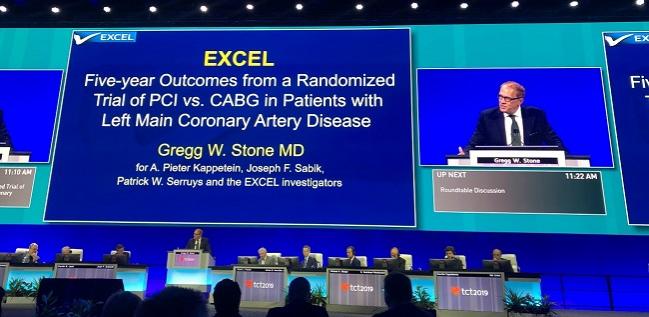EXCEL at 5 Years: PCI for Left Main CAD Still Noninferior to CABG
Adverse events linked to PCI intensified over time compared to CABG, and long-term comparative efficacy remains unknown.

SAN FRANCISCO, CA—A new analysis of the EXCEL trial shows that PCI continues to be noninferior to CABG through 5 years for patients with left main CAD, investigators reported here today.
As reported by TCTMD in 2016, the main, 3-year EXCEL results also showed that PCI is noninferior to CABG. In both cases, the primary endpoint was a composite that included death, stroke, or MI. The study released this morning sought to determine if PCI retained comparable efficacy to CABG over the subsequent 2 years.
The quick answer? It does. As expected and as previously, in the first few months after the procedure, PCI outperformed CABG. But a longer time horizon shows a shifting story.
“The early benefits of PCI due to reduced periprocedural risk were attenuated by the greater number of events occurring during follow-up with CABG, such that at 5 years the cumulative mean time free from adverse events was similar with both treatments,” according to co-principal investigator Gregg W. Stone, MD (Icahn School of Medicine at Mount Sinai, New York, NY), who presented the 5-year EXCEL follow-up here at TCT 2019.
The results were published simultaneously in the New England Journal of Medicine.
Stone and colleagues tracked outcomes in 1,905 patients with left main CAD of low or intermediate complexity (SYNTAX score of 32 or less) who were randomly assigned to PCI (n = 948 patients) or CABG (n = 957 patients).
At the 3-year mark, 15.4% of PCI and 14.7% of CABG patients has experienced the primary endpoint of death, stroke, or MI.
With 92% follow-up, the 5-year results show that death, stroke, or MI had occurred in 22% of PCI patients and in 19.2% of CABG patients, such that PCI remained noninferior to CABG.
The event curves for PCI and CABG remain of high interest. “Up to about 36 months, the area under the curve is really patients benefiting from PCI,” Stone explained at a media briefing. “Then after that, patients [begin to] benefit from bypass surgery.”
There were three distinct intervals of relative efficacy between PCI and CABG. From 0 to 30 days there were a greater number of events (death, stroke, or MI) in the CABG-treated patients (8.0%) than in the PCI group (4.9%). From 30 days to 1-year, event rates were similar for PCI (4.1%) and CABG (3.8%), but between 1 and 5 years, PCI patients experienced a higher rate of events than did their CABG counterparts (15.1% and 9.7%, respectively; HR 1.61; 95% CI 1.23-2.12), with curves continuing to diverge over time.
It is not simply a case of PCI efficacy declining as CABG retains patency over time, Stone emphasized. “By the end of the 5-year follow-up period there was an absolute 5.2 days of event-free additional survival in the PCI arm compared to the surgical arm.” This finding is not statistically significant in favor of PCI, given the wide confidence intervals. For that reason, Stone stated that for practical purposes this represents “a very similar event-free survival of the burden for these two therapies at the end of 5 years.”
Choices for Patients
Given the similar overall trajectories, Stone emphasized that clinicians should discuss with their patients whether PCI or CABG would be best in each individual case. “PCI may be considered an acceptable revascularization modality for selected patients with left main disease, a decision which should be made after heart team discussion, taking into account each individual patient’s risk factors and preferences,” Stone concluded at the media briefing.
The key question is whether these curves will continue to diverge over time. In the NEJM paper, the investigators recommended a 10-year or longer follow-up to “characterize the very late safety profiles of PCI and CABG, since both stents and bypass grafts fail progressively over time.”
Marie-Claude Morice, MD (Ramsay Générale de Santé, Massy, France), an EXCEL investigator as well as the co-principal investigator of the landmark SYNTAX trial, supports this approach. “The fact that it’s diverging doesn’t mean that it will continue to diverge,” Morice observed. “For the moment, we can say to the patients that at least at 5 years [they are identical], and so PCI is not a dangerous option.”
Abbott Vascular, which funded the 5 year EXCEL analysis, has not committed to funding a longer longitudinal study.
Stone discussed numerous secondary outcomes of the EXCEL trial during his formal presentation at TCT 2019. These outcomes are “hypothesis-generating,” Stone noted, since they were not powered to reach statistically definitive conclusions. Death from any cause was numerically higher for PCI than for CABG (119 compared to 89 respectively), whereas there was a higher incidence of therapy failure, defined as definite stent thrombosis or symptomatic graft stenosis or occlusion, for CABG (58 patients) than for PCI (10 patients).
The data showing higher all-cause mortality for PCI compared to CABG spurred conversation during the panel discussion at TCT 2019. “The mortality finding is a concern, but to me it’s plausible that this is a chance finding when you put it alongside the evidence from other comparable trials,” Stuart J. Pocock, PhD (London School of Hygiene and Tropical Medicine, England), observed.
Also during the panel discussion, Davide Capodanno, MD, PhD (University of Catania, Italy), highlighted the implications of recommending PCI over CABG. “When we discuss [options] with a patient, we have to be aware that we are promoting something that is better at the very beginning and maybe in the long run will be a little bit worse,” Capodanno said.
Note: Stone is the Co-Director of Medical Research and Education at the Cardiovascular Research Foundation, the publisher of TCTMD.
This story was updated to include conflicts of interest for Stone, provided in the NEJM paper.
Marcus A. Banks is the 2019 recipient of the Jason Kahn Fellowship in Medical Journalism. He is currently a master’s…
Read Full BioSources
Stone GW, Kappetein AP, Sabik JF, et. al. Five-year outcomes after PCI or CABG for left main coronary artery disease. N Engl J Med. 2019;Epub ahead of print.
Disclosures
- Stone reports grants from Abbott during the conduct of the study; personal fees from Terumo, Amaranth, Shockwave, Valfix, TherOx, Reva, Vascular Dynamics, Robocath, HeartFlow, Gore, Ablative Solutions, Matrizyme, Miracor, Neovasc, V-wave, Abiomed, Claret, Sirtex, and MAIA Pharmaceuticals; personal fees and other from Ancora, Qool Therapeutics, SpectraWave, and Orchestra Biomed; and other from Cagent, Applied Therapeutics, Biostar family of funds, MedFocus family of funds, and Aria outside the submitted work. Columbia University receives royalties from Abbott for sale of the MitraClip.


Comments